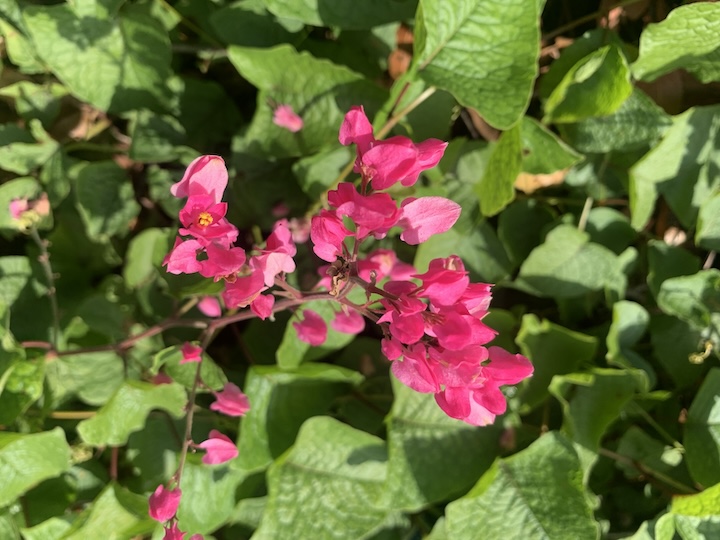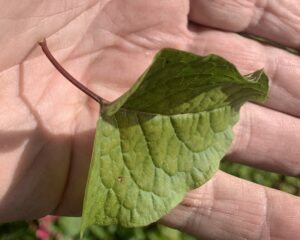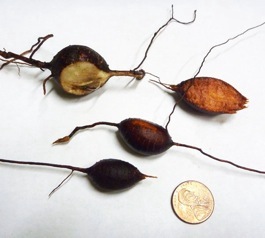
Coral Vine is not a slow creeper. Photo by Green Deane.
Antigonon leptopus: Creeping Cuisine
The Antigonon leptopus ( an-TIG-oh-non LEP-toh-puss) inspires local names everywhere it grows: Tallahassee Vine, Honolulu Creeper, the Christmas Island Crawler, as well as Confederate Vine, Mexican Coral Vine, Mexican Creeper, Chinese Love Vine, Chain of Love, Queen’s Jewels, Desert Bleeding Heart, and Queen’s Wreath. Other names include: Kadena de Amor, Flor de San Diego, Rosa de Mayo, Corona de Reina, Hierba de Santa Rosa, San Miguelito, and Fulmina. Natives called it Coamecate, Coamecatl, Chak lol makal, Cuamécatl, Gui-bakushu, Mamasa-sai and Tunuc. It’s also called the Rose of Montana, but does not grow there. In most countries where bellies are full, it’s called an invasive weed.

Antigonon leptopus has a long stem. Photo by Green Deane
Related to the seagrape and in the buckwheat family, the Coral Vine is a native of Mexico and is widely cultivated in South America. In other pan tropical places it is an escaped ornamental. It tolerates poor soil and a variety of light conditions. While a hungry man would view that as a reliable food source, most first-world governments think of it as difficult to eradicate. In Florida, where it is naturalized, it is considered a Category II invasive exotic (I have often wondered why they don’t think the same way about non-native citrus.)
A fast-growing climber, the Coral Vine grabs via tendrils and can reach 40 feet in length in old age. Its leaves are heart shaped, sometimes triangular, crinkly edged, with reticulated veins (looks wrinkled.) They are officially around one three inches long though I think they grow larger. The flowers are arranged in panicles, pink to white, blooming from spring to fall, many times year around. It is an evergreen in some climates or looses its leaves for a little while in other areas.
The Coral Vine is well-equipped to proliferate itself. It produces a huge amount of seeds, which also float. The edible seeds, and or other parts of the vine, are favored by birds, raccoon, deer, pigs and sheep. Bees and butterflies like it because least least 41.6% of its flowers are open at a given time. The plant can also reproduce via its edible tuber which grows larger with age. It likes pinewoods, fence rows, yards, disturbed ground even marshy areas. Climbing by tendrils, it tends to smother what it ascends.
Least you think the Coral Vine is just another pretty invader it’s medicinal as well. An extract of its leaves and flowers inhibit lipid peroxidation. It’s an antioxidant, anti-inflammatory and analgesic. A hot tea made from the aerial parts is used to relieve symptoms of the cold and flu. A leaf tea is also made to treat diabetes and high blood pressure. In the kitchen the cooked roots are nutty, and the leaves and flowers are dipped in flour, fried and served with pasta. The flowers are also mixed into omelet. The seeds can be roasted, winnowed, then ground and used like flour.
Antigonon is from Greek and means opposite angle, think elbow, a reference to the blossom arrangement. Leptopus is a Greek/Latin mess that comes from the Greek word Leptos meaning thin or delicate. Lepta is pocket change and lepto is a moment. If you prefer the Greek the pronunciation would be LEP-toh-puss (as in cat.) The Latin would favor lep-TOE-puss. There are four to eight species of Antigonon — depending on who is counting. A second one grows in south Florida, A. guatemalense. It has larger leaves and hairy stems. Its edibility is unknown to me.
The vine is found throughout the southern United States, Central America and South America. It is also found on Africa — it got to Egypt by 1805 — and 98% of the Pacific Islands including American Samoa, the Commonwealth of the Northern Mariana Islands, Cook Islands, Federated States of Micronesia, Fiji, French Polynesia, Galapagos Islands, Guam, Hawai‘i, Kiribati, Marshall Islands, Midway Island, Nauru, Niue, Palau, Papua New Guinea, Pitcairn Island, Samoa, Tonga, the Philippines. It is also found on most islands in the Caribbean. It can be grown as an annual or a container plant at least as far north as St. Louis. It is also found in India, Australia, and England, and is known to grow in southern California but not blossom there.
Green Deane’s “Itemized” Plant Profile
IDENTIFICATION: A twining vine, clings and climbs with curled tendrils to 40 feet. Leaves: ovate, heart-shaped, soft, pronounced veins on underside, reticulated on top. Flowers: on branch terminals, reddish or light pink, or white. Petioles 2cm or longer, whereas on the A. guatemalense they are 1 cm or shorter.
TIME OF YEAR: Roots anytime they are large enough to harvest, often deep. Blossom when in season, in warm areas nearly year round, in cooler areas until frost.
ENVIRONMENT: Nearly any environment will do. Flourishes with good water and plenty of sun
METHOD OF PREPARATION: Roots cooked — some say raw, I do not personally know that — seeds roasted and winnowed. Flowers and leaves cooked.
HERB BLURB
Tea prepared from the aerial parts of Antigonon leptopus is used as a remedy for cold and pain relief in many countries. In this study, A. leptopus tea, prepared from the dried aerial parts, was evaluated for lipid peroxidation (LPO) and cyclooxygenase (COX-1 and COX-2) enzyme inhibitory activities. The tea as a dried extract inhibited LPO, COX-1 and COX-2 enzymes by 78%, 38% and 89%, respectively, at 100 microg/ml. Bioassay-guided fractionation of the extract yielded a selective COX-2 enzyme inhibitory phenolic aldehyde, 2,3,4-trihydroxy benzaldehyde. Also, it showed LPO inhibitory activity by 68.3% at 6.25 microg/ml. Therefore, we have studied other hydroxy benzaldehydes and their methoxy analogs for LPO, COX-1 and COX-2 enzymes inhibitory activities and found that compound 1 gave the highest COX-2 enzyme inhibitory activity as indicated by a 50% inhibitory concentration (IC(50)) at 9.7 microg/ml. The analogs showed only marginal LPO activity at 6.25 microg/ml. The hydroxy analogs 6, 7 and 9 showed 55%, 61% and 43% of COX-2 inhibition at 100 microg/ml. However, hydroxy benzaldehydes 3 and 12 showed selective COX-1 inhibition while compounds 4 and 10 gave little or no COX-2 enzyme inhibition at 100 microg/ml. At the same concentration, compounds 14, 21 and 22 inhibited COX-1 by 83, 85 and 70%, respectively. Similarly, compounds 18, 19 and 23 inhibited COX-2 by 68%, 72% and 70%, at 100 microg/ml. This is the first report on the isolation of compound 1 from A. leptopus tea with selective COX-2 enzyme and LPO inhibitory activities.
Bioactive Natural Products and Phytoceuticals, 173 National Food Safety and Toxicology Center, Michigan State University, East Lansing, MI, USA. nairm@msu.edu.


